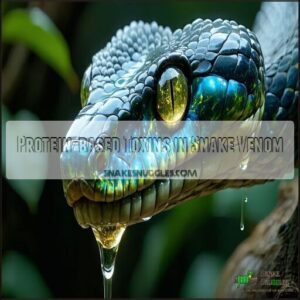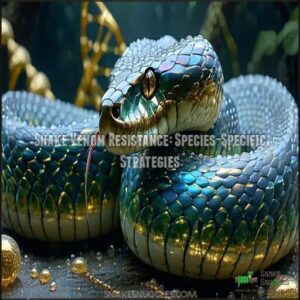This site is supported by our readers. We may earn a commission, at no cost to you, if you purchase through links.
 You’ll find it fascinating that snakes don’t fall victim to their own venom through several clever biological adaptations.
You’ll find it fascinating that snakes don’t fall victim to their own venom through several clever biological adaptations.
Their specialized venom glands isolate toxic compounds from their bloodstream, while their immune system produces proteins that neutralize any venom that accidentally enters their circulation.
Snakes also possess modified cell receptors that simply don’t respond to their venom’s effects – like having a lock that their own key can’t open, which is akin to wearing protective gear against your own weapons.
Some species even produce specific inhibitor proteins that render venom components harmless, revealing nature’s remarkable evolutionary solutions.
The full story of how snakes are immune to their own venom is a testament to these complex mechanisms.
Table Of Contents
- Key Takeaways
- Snake Venom Composition and Mechanisms
- Biological Adaptations for Venom Immunity
- Snake Venom Resistance: Species-Specific Strategies
- Evolution of Snake Venom Immunity
- Implications of Snake Venom Immunity
- Frequently Asked Questions (FAQs)
- Are snakes immune to Venom?
- How do monitors exhibit immunity to snake venom?
- Are snakes susceptible to their own venom?
- Why do snakes have anti-venom antibodies?
- How do snakes protect themselves from their own venom?
- Can a snake hurt itself with its own venom?
- What makes snakes immune to venom?
- How do venomous snakes not poison themselves?
- How do snakes resist their own venom?
- Can snakes hurt themselves with their own venom?
- Conclusion
Key Takeaways
- Snakes don’t poison themselves because their blood has specialized proteins and antibodies that neutralize their venom.
- Their venom glands are securely designed to store toxins without leaking or causing harm.
- Genetic mutations modify their cell receptors, making them resistant to their venom’s effects.
- Enzymes in their bodies break down toxins, acting as a built-in cleanup system.
Snake Venom Composition and Mechanisms
Snake venom is a powerful cocktail of proteins, enzymes, and toxins designed to immobilize prey and begin digestion.
It works by targeting specific systems in the body, like nerves or blood, with precision that might remind you of a biological scalpel, using a biological approach to achieve its effects.
Protein-based Toxins in Snake Venom
Snake venom is a powerhouse of protein structures, crafted for maximum impact.
These venom proteins disrupt prey’s systems with precision.
- Toxin Classification: Neurotoxins paralyze, while enzymes shred tissues, showcasing venom potency.
- Enzyme Activity: Proteins aid toxin spread, ensuring efficiency.
This cocktail evolves constantly, sharpening its edge in nature’s arms race.
Venom resistance mechanisms help snakes survive their own deadly brew.
Neurotoxins, Hemotoxins, and Cytotoxins
Think of venom as a biochemical toolbox.
Venom: nature’s deadliest chemistry set, perfected through millions of years of evolutionary experimentation.
Neurotoxins cause paralysis by scrambling nerve signals, hemotoxins wreak havoc on blood cells and vessels, while cytotoxins destroy tissue with surgical precision.
These toxins don’t act alone—they form deadly synergies designed for prey.
Venom potency varies by species, but snake venom immunity guarantees they’re safe from their own arsenal, thanks to specialized venom resistance mechanisms.
Understanding snake venom composition is vital for developing effective antivenoms.
Venom Glands and Delivery Systems
While it might seem risky for snakes to carry their own deadly venom, their bodies are marvelously designed to manage it. Venom glands act like secure vaults, storing snake venom toxins safely until needed.
These modified salivary glands produce and house a potent mix of proteins and enzymes, ready for action.
- Fang Mechanisms: Venom travels through specialized ducts to hollow fangs, guaranteeing precise venom injection into prey. This design prevents accidental self-envenomation.
- Venom Regulation: Snakes can control the amount released, sometimes delivering "dry bites" without venom.
This careful system, shaped by gland evolution, keeps snakes safe while maximizing hunting efficiency. Nature’s ingenuity guarantees these predators stay both lethal and protected.
Target-specific Action of Snake Venom
Snake venom works like a precision tool, targeting specific tissues and processes.
Its tissue specificity allows it to:
- Disrupt nerve signals via receptor binding, causing paralysis.
- Turn blood into sludge, damaging vessels and blocking clotting through systemic effects.
- Break down tissues with enzymes, aiding spread.
This cellular mechanism guarantees prey vulnerability while snakes avoid harm through self-envenomation resistance and venom detoxification adaptations.
Evolutionary Purpose of Snake Venom
Venom isn’t just a weapon—it’s a survival masterpiece.
Through venom evolution, snakes developed this potent mix to immobilize prey, kickstart digestion, and fend off threats.
It’s also a defense mechanism against predators and rivals during intraspecies competition.
This evolutionary adaptation guarantees efficiency in hunting and survival, fine-tuned by natural selection to match their environment and prey specialization.
Biological Adaptations for Venom Immunity
You might wonder how snakes manage to survive their own venom without a hitch.
Their bodies have evolved remarkable adaptations, like specialized proteins and enzymes, to neutralize toxins and protect essential systems.
Genetic Mutations in Venom-resistant Snakes
Over time, genetic mutations have fine-tuned snake venom immunity, making their bodies resistant to their own toxins.
These mutations include:
- Gene duplication creating extra copies of venom-neutralizing proteins.
- Point mutations altering protein isoforms to block venom binding.
- Regulatory changes enhancing toxin-neutralizing enzymes.
This evolutionary ingenuity guarantees snakes survive their venomous bites, turning a deadly weapon into a harmless tool.
Modified Venom Receptors in Snake Bodies
Snakes owe their venom resistance to receptor mutations that tweak binding affinity.
These structural changes block venom toxins from latching onto critical sites, ensuring functional impact is minimal. It’s like changing the locks on a door—venom simply can’t “unlock” harm.
- Modified target sites
- Reduced toxin binding
- Genetic mutations at play
- Evolutionary advantage in immunity
- Enhanced snake venom immunity
Blood-venom Barrier in Snake Circulatory Systems
The blood-venom barrier is a fascinating defense mechanism that keeps snakes safe from their own venom.
Think of it as a biological firewall, stopping venom from wreaking havoc internally. This system relies on specialized endothelial protection and venom sequestration, ensuring toxins stay out of critical tissues.
Nature’s perfect firewall: specialized protection keeping deadly toxins at bay while allowing snakes to wield their venomous arsenal.
Here’s how it works:
- Barrier mechanisms prevent venom absorption.
- Venom binding proteins neutralize toxins in the bloodstream.
- Lymphatic role controls venom movement.
- Cellular defense minimizes tissue damage.
- Toxin neutralization by venom antibodies enhances snake immunity.
Each species fine-tunes this process, showcasing nature’s brilliance in building snake venom immunity.
Specialized Enzymes Neutralizing Self-produced Venom
Notably, snake physiology relies on enzyme specificity and inhibitor mechanisms to combat self-produced venom.
Enzymatic inhibitors like phospholipase A2 and serine protease act as protein scavengers, breaking down toxins and preventing harm.
These detoxification pathways guarantee venom degradation before it causes damage.
Think of it as a built-in cleanup crew, neutralizing venom through precise venom neutralization processes.
This clever adaptation highlights their remarkable venom resistance and survival strategy in the wild.
Physiological Changes Enhancing Venom Tolerance
To tolerate venom, your body undergoes clever physiological adaptations.
These include:
- Receptor Modification: Target molecules are altered, reducing venom’s impact.
- Enzyme Production: Specialized enzymes neutralize toxins before they cause harm.
- Blood Barriers: Protective barriers limit venom spread, acting like a biological firewall.
These adaptations also involve cellular stress responses within venom glands.
These metabolic adaptations and immunity mechanisms make selfenvenomation manageable, showcasing the brilliance of snake physiology and its venom resistance strategies.
Snake Venom Resistance: Species-Specific Strategies
You’ll find that different snake species have evolved unique molecular defenses that protect them from their own toxic cocktails.
These specialized adaptations range from modified venom receptors in rattlesnakes to specialized neutralizing proteins in cobras, allowing these remarkable reptiles to produce deadly toxins without poisoning themselves, which is a testament to their remarkable ability to survive.
Cobra Family Immunity Mechanisms
The cobra family’s remarkable immunity mechanisms involve vital receptor mutations at the molecular level.
You’ll find these elapids possess modified nicotinic acetylcholine receptors that prevent α-neurotoxin binding, creating an elegant self-protection system.
Their specialized venom tolerance stems from unique genetic adaptations that alter receptor binding sites, effectively neutralizing their own three-finger toxins.
This built-in neurotoxin resistance shields cobras from potentially deadly self-envenomation, demonstrating nature’s sophisticated defense strategies.
Rattlesnake Venom Resistance Adaptations
Sporting remarkable defenses, rattlesnakes have evolved sophisticated venom resistance adaptations through millennia of natural selection.
Their immune response includes specialized serum proteins that neutralize their own toxic cocktails.
- Feeling awestruck at a rattlesnake surviving what kills its prey
- Marveling at the evolutionary advantages that kept these creatures alive
- Wondering how their bodies developed such precise defenses
- Imagining the genetic mutations that created this superpower
- Appreciating nature’s perfect design when snake venom meets snake immunity
Rattlesnake venom resistance relies on modified blood proteins, creating a biological shield against self-envenomation. This venom tolerance varies between species, reflecting each rattlesnake’s unique adaptations.
Viper Species’ Self-protection Methods
While rattlesnakes have their tricks, viper species employ a fortress-like defense system against their own potent venom. Think of their immunity as a castle with multiple security layers.
- Specialized immune cells attach to venom molecules in the bloodstream, neutralizing them efficiently
- A phenomenon called "self-immunity" prevents sensitivity to their own venom
- Strategic gene mutations create venom resistance at the cellular level
- Electrostatic mechanisms help contain venom within specialized glands
- Rare cases of self-envenomation confirm these protection methods aren’t foolproof
You’ll find viper immunity fascinating—these snakes couldn’t survive without venom resistance adaptations. Their bodies have evolved remarkable toxin neutralization systems that prevent accidental self-envenomation while maintaining deadly weapons for hunting. These snakes exhibit resistance via mutations in nerve cell receptors.
Elapid Snakes’ Immunity Features
Elapid snake-resistance showcases remarkable natural immunity against potent neurotoxins. Their venom proteins would kill other creatures, yet these reptiles thrive with specialized protection systems.
Three key immunity features include:
- Modified acetylcholine receptors that prevent alpha-neurotoxin binding
- Specialized elapid antibodies that neutralize their own venom components
- Genetically-evolved immune cells that recognize and deactivate toxins
This reptile immunity represents nature’s perfect defense mechanism. Some snakes even exhibit species-specific venom compositions.
Variations in Immunity Across Snake Subfamilies
While Elapid snakes rely on specialized receptor modifications, immunity mechanisms vary dramatically across snake subfamilies.
You’ll find that each family has evolved unique defenses against their own toxins.
Vipers showcase remarkable resistance through specialized blood-venom barriers that prevent their hemotoxins from damaging their own tissues.
Rattlesnake defenses include circulating inhibitors that neutralize their venom proteins before they can cause harm.
In contrast, Colubridae members possess more basic enzyme systems with limited protection, reflecting their generally less potent venoms.
Marine snake subfamilies (Hydrophiidae) have developed distinct antibodies suited to their aquatic environment.
This subfamily comparison reveals how reptile immunity has evolved along different evolutionary paths.
Each snake species’ immune response represents a finely-tuned adaptation—nature’s solution to the fascinating paradox of producing deadly toxins without self-harm.
Evolution of Snake Venom Immunity
You’ll find it fascinating how snake venom immunity has evolved through millions of years of genetic adaptation, driven by the need to survive accidental self-envenomation and intraspecies conflicts.
This evolutionary process has produced specialized proteins and modified receptor sites that protect venomous snakes from their own toxins while maintaining the venom’s effectiveness against prey, which is a result of millions of years of adaptation.
Natural Selection Driving Venom Resistance
From species-specific strategies to broad evolutionary patterns, we now see how nature’s invisible hand shapes these defenses.
Natural selection drives venom resistance through a fascinating evolutionary process. When intraspecies bites occur, snakes with mutation advantages survive and pass on their resistance inheritance.
Evolution rewards venom tolerance through:
- Genetic mutations creating target site modifications
- Enhanced immune response systems neutralizing toxins
- Survival pressure eliminating vulnerable individuals
- Gradual improvement of snakebite resistance over generations
This evolutionary arms race guarantees snakes maintain effective venom defense mechanisms without poisoning themselves—nature’s brilliant solution to a deadly paradox, ensuring species survival and highlighting the importance of natural selection.
Co-evolution of Venom Potency and Immunity
While natural selection sets the stage, the co-evolution of venom potency and immunity creates an intricate evolutionary dance.
You’ll find snake venom constantly adapting alongside resistance mechanisms in a perpetual genetic arms race.
- Venom defense mechanisms evolve specifically to counter prey adaptations
- Snakebite resistance develops as coevolutionary drivers push immunity evolution
- Snake venom complexity increases with prey evolutionary diversity
- Target site modification emerges as prey develop evolutionary adaptations to toxins
This predator-prey dynamic shapes both snake venom composition and the immunity snakes need against their own biochemical weapons.
This highlights how venom genes evolve rapidly, making them ideal for research on evolutionary processes, especially in understanding genetic arms race and biochemical weapons.
Genetic Basis for Venom Immunity Development
As venom potency evolves, so does genetic immunity. The secret to snake survival lies in their DNA—a fascinating blueprint of protection mechanisms.
Your immune system would collapse against venom toxins, but snakes have developed remarkable genetic adaptations:
- Single gene mutations creating specialized venom-neutralizing proteins
- Receptor modifications preventing toxin binding to target cells
- Enhanced blood barriers blocking venom entry to essential systems
- Enzyme specialization that breaks down self-produced toxins
These genetic defenses aren’t random—they’re precisely crafted evolutionary solutions to the deadly puzzle of self-immunity.
Evolutionary Arms Race With Prey Species
The never-ending evolutionary arms race between venomous snakes and their prey drives the remarkable development of both venom potency and prey resistance.
When animals like mongooses and honey badgers develop immunity to snake venom, predators must evolve stronger toxins to maintain their edge.
This coevolution dynamics creates constant predation pressure, forcing both sides to continuously adapt, in a process of toxin innovation that guarantees survival for these fascinating reptiles, where the ultimate game of one-upmanship plays out.
Adaptive Radiation in Venomous Snake Lineages
While prey species develop resistance to venom, snakes themselves undergo fascinating evolutionary splits.
Adaptive radiation occurs as snake lineages spread to new environments, creating venom diversification through geographic isolation.
Your typical venomous snake adapts its toxins based on:
- Local prey availability
- Competitive pressures from other predators
- Genetic drift in isolated populations
- Environmental factors affecting protein expression.
This niche partitioning leads to remarkable phenotypic plasticity in venom composition.
Snake venom contains various enzymes and proteins suited for specific effects.
Snake adaptations don’t just happen overnight—they’re the result of millions of years of evolutionary fine-tuning. Isn’t nature clever to develop such complex systems through natural selection?
Implications of Snake Venom Immunity
You’ll be amazed by how snake venom immunity extends far beyond self-protection, offering groundbreaking insights for medical treatments and antivenom production.
The specialized proteins and enzymes that protect snakes from their own toxins could transform how we address venomous bites and treat various diseases, making these slithery creatures unexpected heroes in medical research.
Medical Applications of Snake Venom Resistance
From evolutionary adaptations to medical breakthroughs, snake immunity mechanisms have opened exciting frontiers in healthcare.
Bioactive peptides from snake venom are being developed into therapeutic proteins for cancer treatments and cardiovascular medicines.
Scientists are isolating toxin inhibitors for pain management, while antibodies from immune snakes guide drug discovery efforts.
This remarkable research has already yielded medications for heart conditions, with promising applications for antibiotic-resistant infections on the horizon, through the use of bioactive peptides.
Antivenom Development Inspired by Snake Immunity
Through the lens of snake immunity, scientists have dramatically transformed antivenom development by studying how venomous serpents resist their own deadly cocktails.
You’ll find these immunity-inspired innovations fascinating:
- Broad-spectrum antibodies like the revolutionary 95Mat5 now neutralize toxins from dozens of snake species across continents
- Synthetic antibodies eliminate dangerous snake milking procedures while improving treatment consistency
- Recombinant antivenoms mimic the snake’s natural immunity mechanisms with higher success rates
- Peptide inhibitors designed to copy snakes’ electrostatic defense strategies protect against multiple venom components
- Immunity mimicry approaches replicate the specialized enzymes snakes use to neutralize self-produced toxins
This biomimetic research isn’t just saving lives in snakebite emergencies—it’s opening new doors for drug development beyond traditional antivenoms, creating treatments that work like the snake’s own built-in protection system. You can find antivenom for sale online.
Ecological Impact of Venom Immunity
Three fascinating ecological dynamics emerge when examining snake venom immunity within natural habitats.
The physiological adaptations that protect snakes from their own toxins fundamentally shape ecosystem balance and species interactions.
| Ecological Factor | Effect | Example | Conservation Implications |
|---|---|---|---|
| Prey adaptation | Resistance development | Mongooses’ cellular defenses | Preserves biodiversity |
| Venom evolution | Toxin diversification | Cobra venom potency shifts | Drives genetic variation |
| Predator advantage | Hunting efficiency | Kingsnakes eating other snakes | Maintains food web structure |
| Interspecies competition | Resource partitioning | Different hunting territories | Supports ecosystem stability |
When snakes maintain their immunity, they secure their ecological niche as apex predators. This triggers continuous biodiversity impact throughout food chains, where both predator and prey must constantly evolve—nature’s biochemical chess match! Snake venom immunity is crucial for this balance, and understanding its implications can help in conservation efforts and recognizing the importance of species interactions.
Challenges in Studying Snake Venom Resistance
While venom immunity forms a critical ecological advantage, researchers face numerous hurdles when studying snake venom resistance.
Investigating these remarkable physiological adaptations requires overcoming:
- Ethical considerations when handling deadly species
- Venom variability across regions and individual snakes
- Sample acquisition challenges from rare or elusive specimens
- Mimicry challenges in replicating natural conditions
- Data interpretation challenges due to overlapping cellular defenses
You’d be surprised how difficult it’s to study immunity in animals that can kill you with a single bite!
Scientists must balance safety protocols with scientific rigor, often working with limited funding and specialized equipment.
This adds to the antivenom production obstacles faced by researchers.
Future Research Directions in Snake Immunity
Snake immunity research frontiers are expanding rapidly in biological sciences.
Scientists now analyze venom resistance genes through genomic sequencing and proteomic analysis, revealing how immune systems neutralize toxins.
You’ll soon see synthetic antivenoms modeled after snakes’ natural defenses, potentially saving thousands of lives annually. Advancements include innovative antivenom products.
Researchers are also investigating the surprising role of microbiome influence in venom resistance. Perhaps most fascinating, immunity transfer technologies could one day protect handlers from deadly bites—imagine wearing the same biological armor that keeps king cobras safe from their own venom, utilizing natural defenses to save lives.
Frequently Asked Questions (FAQs)
Are snakes immune to Venom?
Yes, you’ll find that most snakes are immune to their own venom through specialized proteins in their blood that neutralize toxins.
They’re not universally immune to venom from different snake species, though, which highlights the complexity of venom from various sources.
How do monitors exhibit immunity to snake venom?
Monitor lizards inherit and re-evolve their resistance to neurotoxins. You’ll notice their robust immune systems protect them when hunting venomous snakes, though they’re not completely immune to all snake venoms.
Are snakes susceptible to their own venom?
While mostly immune, snakes aren’t completely protected from their own venom. You’ll find they’ve specialized proteins in their blood that neutralize toxins, but direct bloodstream exposure can still harm them.
Why do snakes have anti-venom antibodies?
Funny enough, snakes naturally produce anti-venom antibodies because their immune systems evolved to handle frequent self-exposure and intraspecies bites.
These antibodies bind to venom toxins, neutralizing them and ensuring the snake doesn’t accidentally harm itself, which is a result of their immune systems handling frequent self-exposure.
How do snakes protect themselves from their own venom?
Snakes protect themselves from their own venom with specialized proteins and antibodies that neutralize toxins.
Their immune systems evolved to block venom’s effects, while their venom glands store it safely, preventing accidental self-poisoning with antibodies.
Can a snake hurt itself with its own venom?
Ironically, a snake can hurt itself with its own venom if it bites in a way that bypasses its natural defenses.
Direct bloodstream entry overwhelms immunity, proving even nature’s designs aren’t foolproof.
What makes snakes immune to venom?
Snakes are immune to their own venom thanks to specialized proteins and antibodies in their blood that neutralize toxins.
Their target sites also evolved reduced sensitivity, ensuring self-defense doesn’t turn into self-destruction, which is made possible by these antibodies.
How do venomous snakes not poison themselves?
Venomous snakes avoid poisoning themselves because specialized proteins in their blood neutralize venom, and their venom glands are sealed off.
Even if bitten, their evolved immunity and resistance mechanisms keep them safe from harm, utilizing specialized proteins to prevent self-poisoning.
How do snakes resist their own venom?
You might find it fascinating that snakes resist their own venom through specialized proteins and antibodies in their blood, which neutralize toxins.
Their venom glands are also designed to prevent accidental self-poisoning.
Evolution’s clever, huh?
Can snakes hurt themselves with their own venom?
It’s rare, but if a snake accidentally injects its venom directly into its bloodstream—like biting itself in a vulnerable spot—it can cause harm.
Their immunity isn’t foolproof, especially with large venom doses.
Conclusion
Picture a snake slithering through its habitat, armed with venom yet completely unharmed by it.
That’s because snakes have evolved ingenious defenses like specialized enzymes, resistant receptors, and immune proteins to neutralize their own venom.
These adaptations reveal how nature crafts precise solutions to complex challenges.
Understanding how snakes are immune to their own venom also unravels evolutionary mysteries and inspires advancements in medicine, from antivenom development to potential treatments for human diseases, which can lead to potential treatments.
- http://www.cdc.gov/niosh/topics/snakes/
- http://www.bbc.com/news/health-34214029
- https://www.sciencedirect.com/topics/pharmacology-toxicology-and-pharmaceutical-science/snake-venom
- https://www.reddit.com/r/herpetology/comments/zpfunx/are_venomous_snakes_immune_to_their_own_venom/
- https://www.sciencefocus.com/news/genetic-mutations-magnetic-resistance-to-snake-venom



















